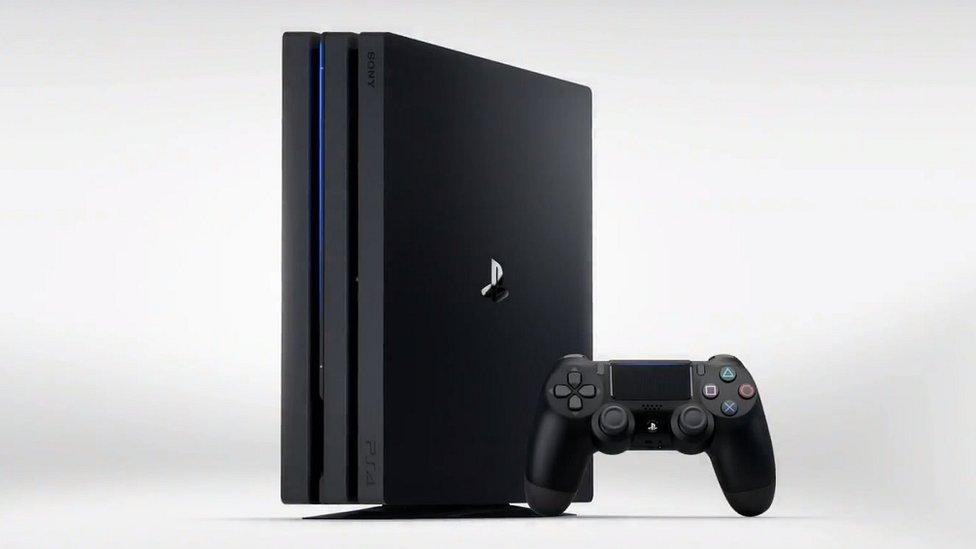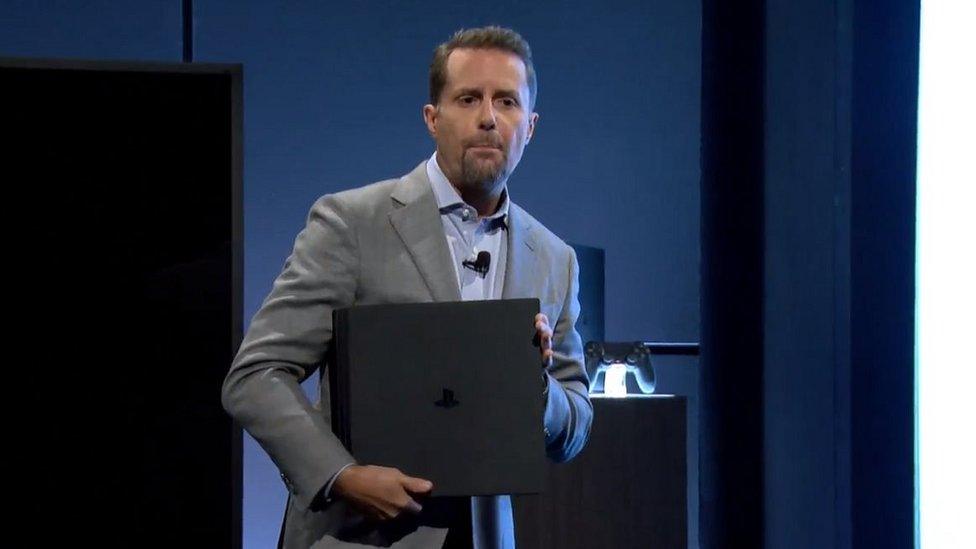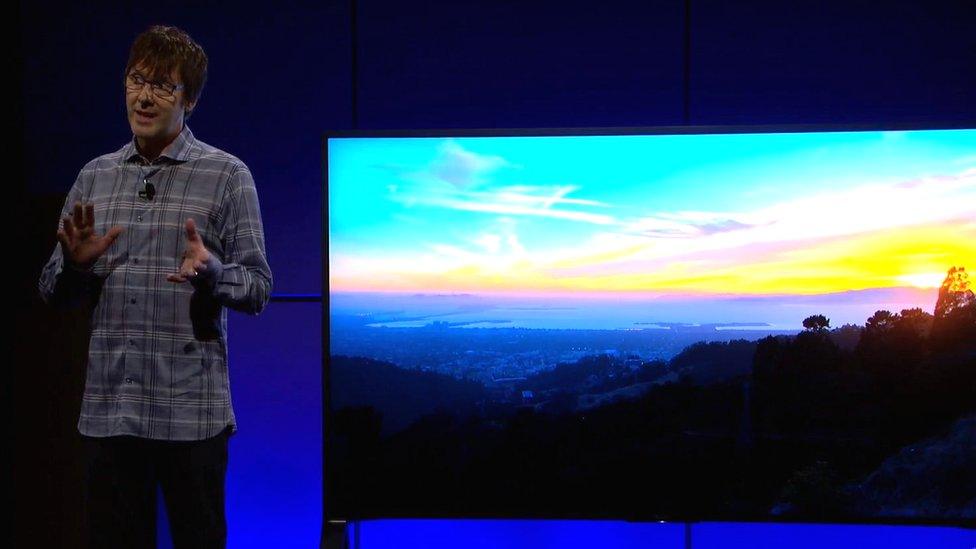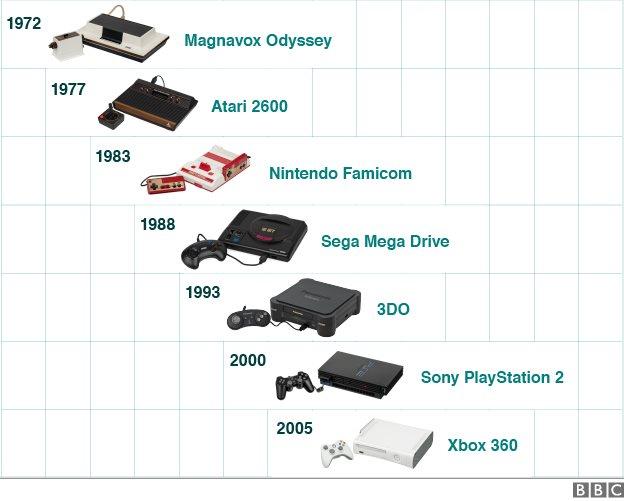Sony reveals PS4 Pro with 4K support
- Published
Michelle Fleury reports from the PlayStation Pro event
Sony has announced a more powerful version of its PlayStation 4 console at an event in New York.
The PS4 Pro will be able to render more detail in games when connected to an ultra-high definition 4K television.
A cosmetically redesigned, slimmer PlayStation 4 was also announced and will be sold at a cheaper price.
One analyst said releasing an upgraded console so soon after the PS4's debut in 2013 took the company into "uncharted territory".
Sony reveals PS4 Pro
Sony typically makes cosmetic changes to the PlayStation between major releases, but this will be the first time it will have two consoles on sale with significantly different graphics capabilities within the same generation.
"We realised that for the very highly-discriminating gamer there is always a desire for advancement, and they want it in this generation," said Sony's Andrew House.

The new console gets a new box
Since outputting games to 4K televisions requires more computing power than HD, Sony said the PS4 Pro would have more than double the graphics processing power of the PS4.
However, unlike Microsoft's Xbox One S, the PS4 Pro will not be able to play 4K Blu-ray movies - a move which has disappointed some fans.
"The PlayStation is primarily a gaming platform, and everything we do is to make the gaming experience as seamless as possible," Jim Ryan, head of PlayStation Europe, told the BBC.

4K offers more detailed pictures than 1080p HD
"We recognise that the trend these days is to use streaming services, and we have a great partnership with Netflix offering 4K movies in its app.
"Both PlayStations continue to support Blu-ray discs."
Advancement
The PS4 was released less than three years ago, alongside rival Microsoft's Xbox One.
Microsoft has already released a slimmer iteration of the Xbox One that can play 4K movies, and is developing a forthcoming console, dubbed Project Scorpio, that it says will support virtual reality and 4K gaming.

Andrew House revealed the new console in New York
"Sony seem to be turning their back on the old console economics of cycles," said Ed Barton, principal analyst at the consultancy Ovum.
"They used to get the core fans in first, and then really make big money when the price of the hardware dropped and appealed to the expanded market.
"Now, they are giving the hardcore gamers a reason to upgrade early."
Sony says the PS4 Pro will be released in November, and games will be compatible with the standard PS4 console.
"PS4 Pro is not intended the blur the lines between console generations," said Sony's Mark Cerny.
"Instead the vision is to take the PS4 experience to extraordinary new levels".
Sony also said it would release a software upgrade to enable high dynamic range (HDR) on all editions of the PS4.
HDR allows a much larger number of colours to be shown. In addition, because it takes advantage of a greater range of brightness levels between black and white, pictures can appear to be more detailed.
Microsoft's Xbox One S also has HDR support.

Mark Cerny said HDR produced more realistic images
Sony is currently thought to be leading the console race, after announcing in May that it had sold 40 million PS4s.
Microsoft said it had sold 10 million Xbox One devices in 2014, but has since stopped reporting its sales figures.
"The biggest advantage that the PS4 has is momentum in the current generation of consoles," said Mr Barton.
"But nobody buys new consoles based on technical specifications, they buy them for the entertainment they enable. They need a strong launch line up of games, or they'll be selling it to a limited number of people."

Key games consoles in history

Magnavox Odyssey: The Odyssey is credited as being the first commercial video games machine for the home. It could only render a single vertical line and three white blocks at a time, so owners had to attach a plastic overlay to their TV to provide the layout for its games.
Atari 2600: Atari's first console to let owners swap in different games cartridges launched alongside nine titles including a Blackjack simulation and the Video Olympics - a cartridge featuring dozens of different variations of its "bat-and-ball" Pong arcade game. But it was 1980's release of Space Invaders and 1982's Pac-Man that cemented its success.
Nintendo Famicom: Launched in Japan two years before it became the NES in Europe. Nintendo provided a "seal of quality" for authorised NES games, helping restore confidence in an industry that had become beset by poor quality releases. Notable titles including Super Mario Bros, The Legend of Zelda and the original Final Fantasy - all of which remain huge franchises.
Sega Mega Drive: Sega's third console - known as the Genesis in the US - proved a much bigger hit outside its home nation of Japan than within. It formed a launchpad for the firm's mascot Sonic the Hedgehog - but only after plans to give the character fangs and a busty human girlfriend were ditched.
3DO: One of the first consoles to offer more colourful 32-bit graphics and the ability to play videos and music as well as games. However, the 3DO was a flop, largely due to its high price. The problem was that its developer licensed the right to make the console to other firms but did not give the manufacturers a cut of software sales, leaving them dependent on the hardware alone for profit.
Sony PlayStation 2: The PS2 remains the bestselling console to date and was only discontinued in 2013. In addition to offering exclusives - including Grand Theft Auto: San Andreas and Gran Turismo 3: A-Spec - it also doubled up as many people's first DVD player.
Xbox 360: Microsoft's console was the first to offer 1080p high definition graphics and built-in wireless connectivity for its controllers. It also helped popularise the idea of using the net to download games and connect with other players via Xbox Live, as well as introducing the Kinect motion control system.

- Published7 September 2016

- Published7 September 2016

- Published14 June 2016
